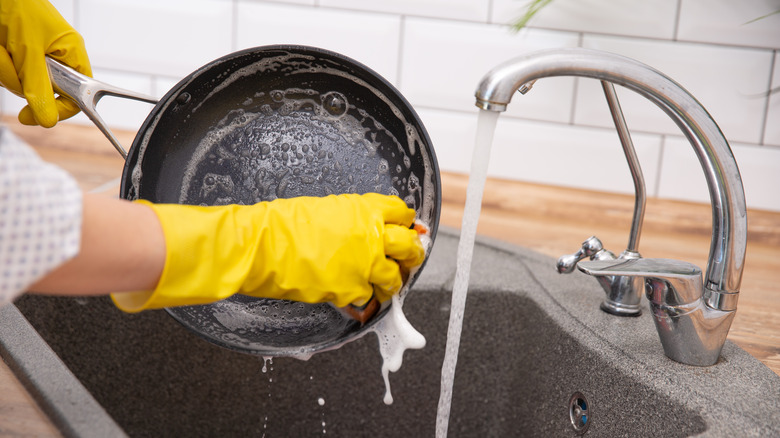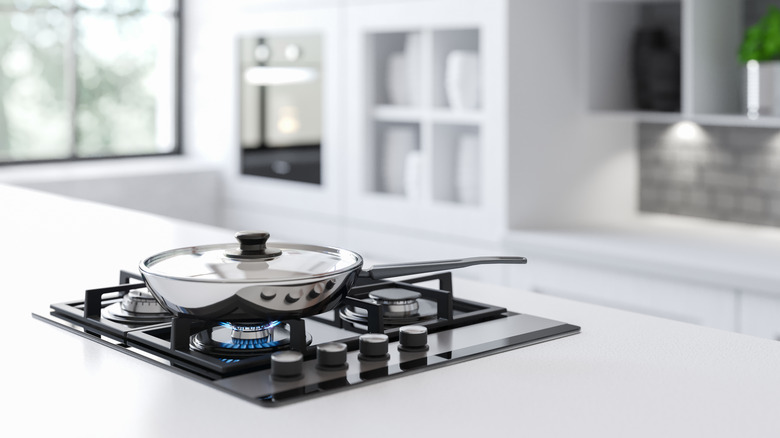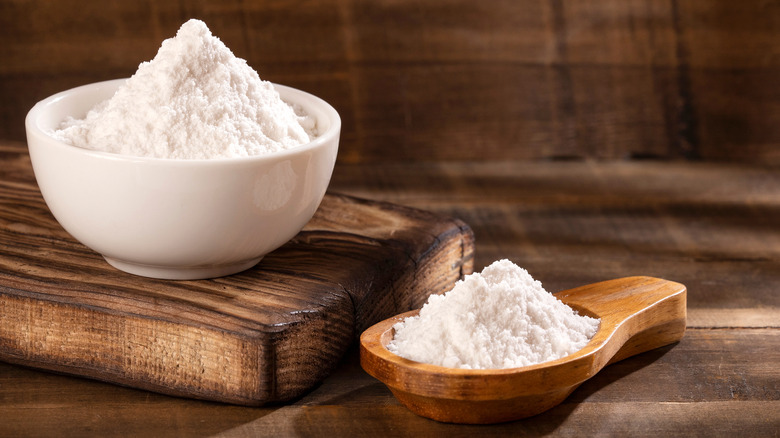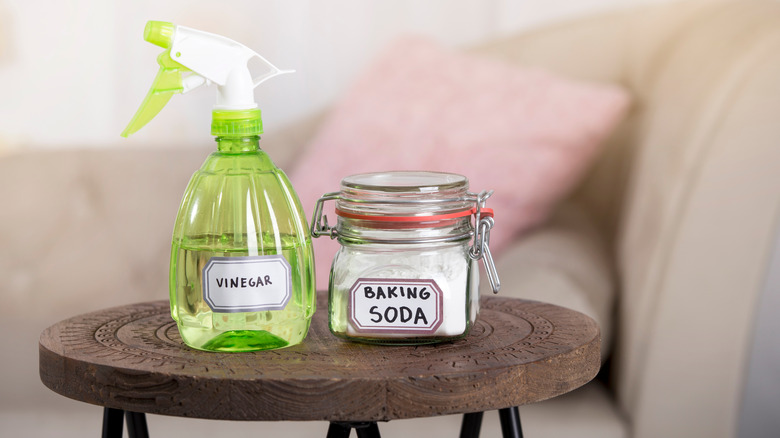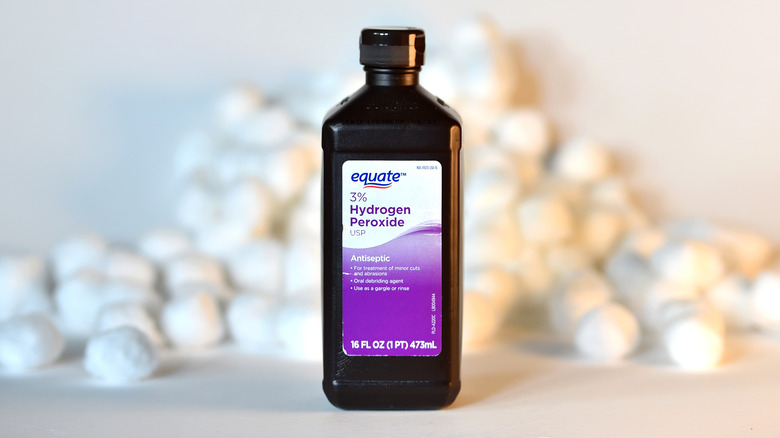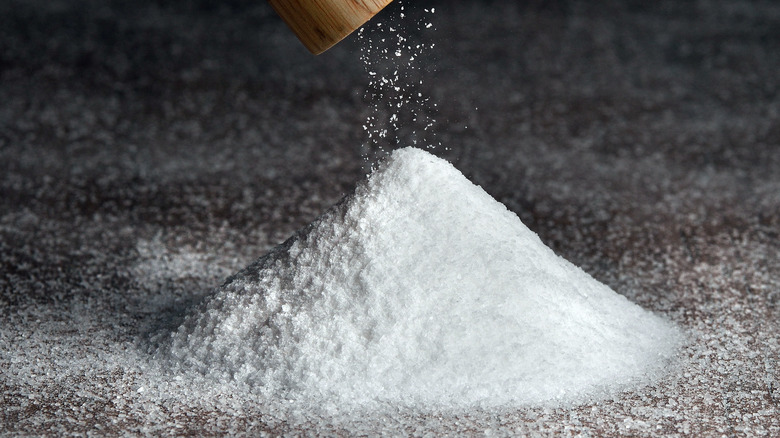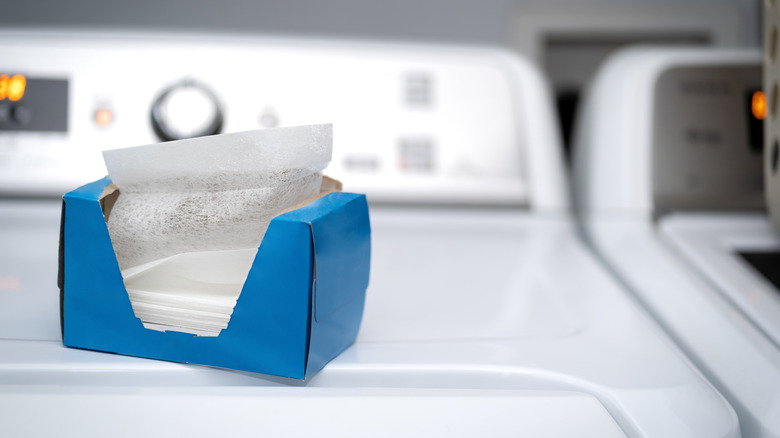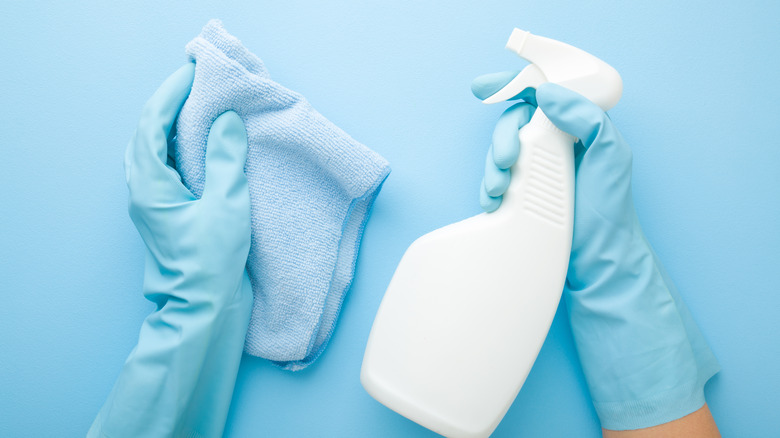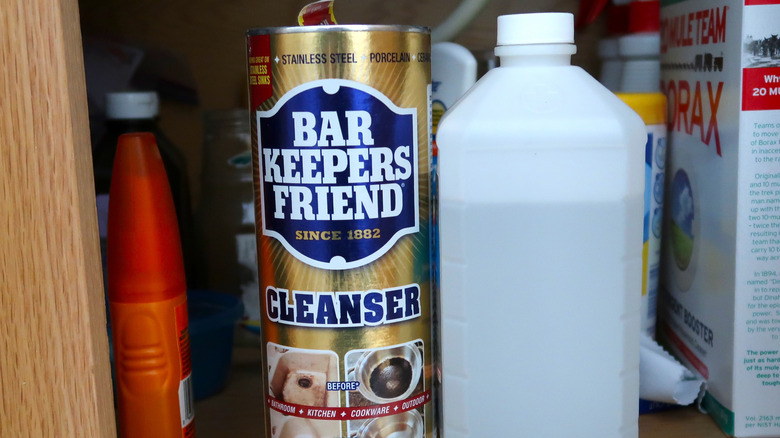8 Easiest Ways To Clean Ceramic Pans
Ceramic pans might be a healthier alternative to non-stick pans, but they have their fair share of drawbacks. People who prefer to use ceramic pans do so because harmful polytetrafluoroethylene such as Teflon isn't present in this cookware. Teflon is in 95% of non-stick pans, which leaches into your food once the compound is heated. According to Healthline, these chemicals can take years to leave the body and can have lasting repercussions. But while ceramic pans might be the healthier alternative, they are much harder to clean than their non-stick counterparts.
Some common struggles with ceramic pans include scorched bottoms, stubbornly burned food, pesky stains, and caked-on residue. But as is true with anything related to cleaning, ceramic pans are easy to clean if you have the right tools and cleaning products. If you use the correct method, hand-washing your dishes shouldn't take longer than five minutes, and it will keep your pan looking brand new for years to come. All you will need is a soft sponge, baking soda, vinegar, salt, hydrogen peroxide, and possibly Bar Keepers Friend. Ahead are some of the easiest ways to clean ceramic pans.
1. Let your ceramic pan simmer on a burner
If you're dealing with just a little bit of scorched food, then fear not: all you need to do is fight fire with fire! According to Caraway, a ceramic cookware brand, the best way to loosen burned food off the bottom of a ceramic pan is to fill the pan with an inch of soapy water and simmer it on low heat. Once the pan has warmed up and the food has loosened, let the water cool, pour it out into the sink, and wipe away the food with a non-abrasive sponge. Rinse out the pan with warm water once you're done.
Just be careful not to singe your fingers while doing this, since the pan still might be warm. To avoid this, use a sponge with a handle so as to steer clear of any unpleasant accidents. If there is still some caked-on food after your first attempt, repeat the process once more until your pan is sparkling clean again.
2. Use baking soda as a scrub on your ceramic pan
Sometimes you need something abrasive when you're met with a stubborn stain, but you don't want to take out a coarse sponge like a brillo pad or a steel wool ball to wash your ceramic cookware. Using these kinds of sponges can create small nicks across your pots and pans, which will eventually wear down the integrity of the non-stick coating, per The Spruce. But what are you supposed to do if you have grease buildup or dried food residue?
The safest way to tackle those issues is to create a soft scrub out of baking soda. The Spruce recommends soaking the pan in warm water for at least 30 minutes before sprinkling baking soda over the problem area. Then using a cloth or soft sponge, wash the dirty section in circular motions, using the baking soda as a light abrasive. If that doesn't work, then you might need to get some water involved. Cover your pan with baking soda, and then add two tablespoons of hot water. This will create a paste, which you then can use to wash the pan with.
3. Clean your ceramic pan with baking soda and vinegar
Baking soda and vinegar can almost always help the situation when you run into a tough stain, especially on your cookware. If you have simmered hot water on your ceramic pan with no results, then create a mixture that includes 1 cup of water, 2 tablespoons of baking soda, and a 1/2 cup of white vinegar. Mix it together to create a cleaning solution, and then scrub your pan with it.
According to Maids 2 Match, baking soda is very absorbent and is especially handy at soaking up grease. Since a lot of ceramic pan stains accumulate caked-on grease, this is an important ingredient to help remove the worst instances of discoloration. On the other hand, vinegar is very acidic and will help to dissolve grease and food, which in turn will make it easier to scrub your pan clean. Using these two ingredients together will help make dishwashing a breeze.
4. Wash your ceramic pan with hydrogen peroxide
If discoloration on your ceramic pan is your main issue, then it's time to reach for the hydrogen peroxide in your first aid kit. If you have food stains and light scorch marks on your pan, then you can lighten those stains with the help of 3% hydrogen peroxide.
Pour half an inch of hydrogen peroxide into the pan, and then add water. If the solution doesn't begin to bubble, then that means your hydrogen peroxide is old and you should use a new bottle, according to The Mode Mag. Let the solution rest on the pan for 30 minutes, and then use a soft brush or cloth to buff away the stains.
Hydrogen peroxide acts as a bleaching agent and lessens the appearance of stains. It breaks the chemical bonds in stains making them appear colorless, which is what you need when you have unsightly splotches all over your pan (via Scientific American). Try out this technique and your pan will look brand new again in no time.
5. Use a pinch of salt to scrub your ceramic pan
Never underestimate the cleaning power of salt! Much like baking soda, it can be used as a mild stain-buster. To use it as a ceramic pan cleaning agent, sprinkle six tablespoons of salt across your pan, and then pour an inch of warm water over the salt, advises The Pan Handler. Let the solution sit for at least 20 minutes, and once the salt has loosened the residue, pour out the water and wash the pan with a soapy sponge.
Salt is a mild abrasive that is known to get rid of tough stains like rust, blood, red wine, and sweat. If you don't wait too long to tackle the stains on your pan, then this salt solution will easily clear them away. But if your stains are stubborn, you can also simmer the salt solution on the stove, which will help loosen the grease and leftover food residue, making it easier to clean.
6. Clean your ceramic pan with dryer sheets
Apparently, dryer sheets aren't just for your laundry room — they're also a valuable resource in the kitchen! Dryer sheets are a great way to wash dirty ceramic pans, and they require you to use little to no muscle power. To begin, Kitchn recommends filling your dirty pan with warm water and adding in a few drops of grease-busting dish soap. Once the residue and grease have softened, put the unscented dryer sheet into the pan and let it soak anywhere between one to five hours, depending on the state of the pan. The food residue and grease will magically loosen, negating any need to scrub or scrape. Afterward, simply take out the dryer sheet, pour out the dirty water, and wash your pan with soap and warm water.
Donna Smallin Kuper, the author of "Cleaning Plain & Simple," told Today Home that the conditioning ingredients in dryer sheets that soften clothes also soften the persistent food residue on pans, making them easier to clean.
7. Spray your ceramic pan with an enzyme solution
Enzyme solutions are known to cut through grease effectively and quickly, which is why they are a great cleaning agent for ceramic pans. Enzyme cleaners are powerful cleaning agents because they help speed up chemical reactions, making the cleaning process faster and easier, as noted by the Chicago Tribune. An example of an enzyme product is Shout Trigger, but you can easily make your own natural version at home.
While there are plenty of enzyme cleaners on the market, making your own ensures that you are using a clean product on your cookware. Love To Know recommends making a mixture out of citrus peels, yeast, distilled water, and brown sugar. Using fruits like lemons, limes, pineapples, and oranges will create a potent cleaning agent because citruses are packed with grime-busting enzymes. The only downside to DIYing your own solution is that it takes about a month for the ingredients to activate, so you have to plan ahead.
8. Use Bar Keepers Friend on your ceramic pan
While there are a million different ways to clean the inside of a pan, what if your problem area is the outside? If you were a little too liberal with your stove's flame and now have scorch marks on the outside of your pan, you might be wondering how to make your cookware look brand new again. The best way to lift those stubborn and unsightly stains is to use Bar Keepers Friend.
Clean My Space recommends adding one part water to three parts Bar Keepers Friend to create a watery paste, and to leave it on your stain for about 10 minutes. Once the cleaning product has soaked into the stain, take a non-abrasive sponge and buff away the discoloration. It should immediately begin to lift.
While scorched and greasy ceramic pans are a pain to look at, there is luckily an endless amount of ways to clean them. You can do everything from utilize natural cleaning agents like baking soda and vinegar to using commercial products like Bar Keepers Friend, but the end result will be the same: You will once again have sparkling pans and pots that will be a joy to cook in.
